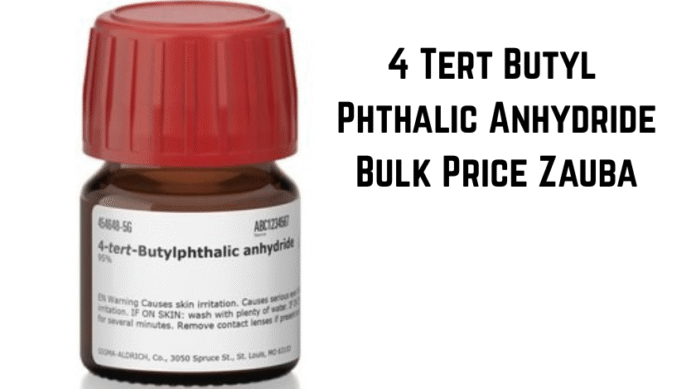Let’s talk chemicals but not just any chemical. We’re diving into 4 tert Butyl Phthalic Anhydride, a compound that may not roll off the tongue easily but holds big importance in industrial chemistry. If you’re dealing with resins, coatings, or advanced polymers, this is likely part of your world. And if you’re looking into bulk pricing, chances are you’ve stumbled across the name Zauba. Wondering what it all means? You’re in the right place.
Understanding the Chemical
Molecular Structure and Properties
4 tert Butyl Phthalic Anhydride is an organic compound derived from phthalic anhydride, with a bulky tert-butyl group attached. It’s solid at room temperature, has a relatively high melting point, and is quite reactive in the right industrial setups.
Common Uses in Industrial Applications
You’ll find this compound used in:
-
Specialty resins
-
High-performance polyesters
-
Certain pharmaceutical intermediates
-
Advanced coating solutions
Its bulky side group makes it ideal for fine-tuning the rigidity and thermal stability of polymer chains.
Global Demand and Supply Trends
Rise in Industrial Use
Thanks to rising demand for high-performance coatings and specialty polymers, the use of this chemical has grown over the last decade. It’s a key player in sectors like:
-
Automotive
-
Construction
-
Electronics
Global Production Hubs
While the U.S. and Europe are significant producers, China and India have ramped up manufacturing in recent years. This surge is due to lower production costs and growing domestic consumption.
Bulk Pricing of 4 tert Butyl Phthalic Anhydride
Factors Influencing Bulk Price
The bulk price can vary widely based on:
-
Purity level of the compound
-
Order quantity
-
Supplier location
-
Logistics & shipping costs
-
Regulatory duties
How Market Dynamics Affect Pricing
When raw material availability drops or energy prices spike, manufacturers increase prices. And if new regulations come in (think environmental or safety), costs can soar.
Seasonal and Regional Price Fluctuations
In India, for example, import volumes tend to rise during Q1 and Q3, affecting pricing. Certain seasonal upticks in demand such as for coatings before monsoons—also play a role.
Zauba: A Key Platform for Price Tracking
What is Zauba?
Zauba is a data platform that tracks import and export transactions across Indian ports. It pulls info from Indian Customs, giving users access to real-time shipment data.
How Zauba Tracks Import and Export Data
Each import entry includes:
-
Product name
-
Quantity
-
HS code
-
Value (INR and USD)
-
Port of entry
-
Supplier and buyer names (in some cases)
Relevance of Zauba in Bulk Chemical Pricing
Zauba provides visibility into what others are paying. That transparency helps businesses benchmark costs, negotiate better deals, and avoid overpaying.
Insights from Zauba Data
Import Trends in India
Zauba data shows that India imports several tons of this chemical annually—mainly from China, Germany, and South Korea. Import volumes have increased due to domestic demand.
Export Trends and Volume
While India isn’t a major exporter of this compound, some bulk is shipped to nearby markets like the Middle East and Southeast Asia.
Average Bulk Price Insights from Zauba
Recent Zauba data suggests average pricing per kg ranges from $4.50 to $7.20 USD, depending on the purity and origin. Prices are often lower when sourced from China due to subsidies and mass-scale production.
Comparing Prices Across Markets
India vs China
India usually pays slightly higher per unit because much of the supply is imported. China benefits from local production and economies of scale.
US Market Comparison
In the U.S., regulations push prices up. The same product might go for $8 to $10/kg, especially if it’s pharma-grade.
European Market Pricing
Europe sees similar trends to the U.S., but value-added taxes and REACH compliance costs can drive prices even higher.
How to Source 4 tert Butyl Phthalic Anhydride at the Best Price
Finding Trusted Suppliers
Look for suppliers with:
-
Strong track record
-
Verified compliance certifications
-
Flexible MOQ (Minimum Order Quantity)
Evaluating Bulk Purchase Options
Check if:
-
Volume discounts apply
-
Shipping terms include CIF or FOB
-
They support recurring orders
Negotiation Tips
Here’s a tip: Use Zauba data as your secret weapon. Show suppliers what others are paying and ask them to match or beat it. You’d be surprised how often this works.
Challenges in Bulk Procurement
Supply Chain Limitations
Global shipping delays, container shortages, and port congestion can lead to weeks of wait and price hikes.
Regulatory Considerations
Countries differ in how they treat chemicals. Some require pre-import registrations, lab tests, or end-use declarations all of which can slow things down.
Future Price Projections
Expected Market Growth
By 2030, the global market for modified phthalic anhydrides is expected to double, driven by innovations in green resins and biodegradable polymers.
Innovation in Applications
New applications in electronic coatings and battery separators could further increase demand, nudging prices upward.
Final Thoughts
Tracking the bulk price of 4 tert Butyl Phthalic Anhydride isn’t just for curiosity it’s a crucial business decision. Whether you’re buying for a factory, lab, or resale, using tools like Zauba gives you the edge. With rising demand and shifting global markets, staying informed is your best strategy for securing the best deals.
FAQs
1. What is the HS code for 4 tert Butyl Phthalic Anhydride?
The common HS Code is 29173500, but this can vary slightly by country.
2. Is Zauba data reliable for procurement decisions?
Yes, Zauba pulls data directly from Indian Customs. It’s one of the best public sources for import/export trends in India.
3. Can individuals import this chemical in bulk?
Technically yes, but you’ll need appropriate chemical handling licenses, and it’s subject to customs regulations.
4. What industries primarily use this compound?
Mainly coatings, resins, plasticizers, and specialty polymers manufacturing sectors.
5. How do geopolitical issues affect the pricing?
Sanctions, trade wars, or regulatory changes in exporting countries can disrupt supply and raise prices sharply.


